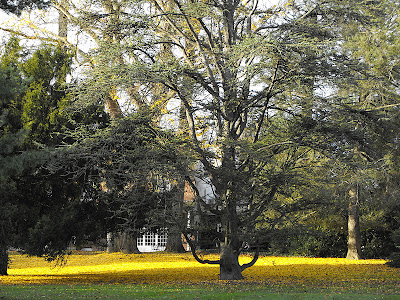Now that many of the winter holidays have passed us (the Winter Solstice, Yalda, Yule, Saturnalia, Hannukah, Christmas, St. Stephen's Day, Boxing Day, Diwali) with only the revelry of New Year's Eve facing us down, we are left to conquer winter--the bulk of which lies before us--with own own devices.
How silent and barren our world has become, compared to our perpetual assailing since before Halloween by the sights and sounds of Christmas: a bombastic proliferation of lights and decorations, a babel of carols, a veritable capitalist orgy of merry making to remind us (aided of course by media reports on "the economy" and weekly retail sales figures) that we have not yet shopped enough, we have not yet dug that debt hole as deeply as others would want.
Yes: January and February seem bleak by comparison. They feel forsaken. Whoever planned the calendar did not do such a good job, leaving us in a lurch as it were. Sure, we have Martin Luther King Day (which for many simply means a mid-January 3-day weekend) and then Valentine's Day--which means not an official respite from work but an appropriation of love, a materialization of an intangible: declare your love with roses, chocolate, jewelry, and haute cuisine, for love itself will not do; indeed, screwed you are (and not in the good sense) if you fail to regale your love-object with treats.
I find some comfort, therefore, in a certain carol: Good King Wenceslas, which seems a fitting tale not merely in the deadness of winter, but also in these Occupy/99% times and post-Havel world. The song celebrates the generosity of a Bohemian duke (907 - September 28, 935) who gave out alms to the poor, and whose footsteps through the deep snows of the Pannonian Plain and Bohemian forest enabled his page, who nearly succumbed to the cold, to continue.
Neither the religious overtones of the tale, nor the Santa-like image in which King Wenceslas has been portrayed, nor even its Valentine's Day undertones (Wenceslas, driven by his love of the Bohemian people informed his benevolent rule, so his hagiographies say) captivate me, however.
I rather find solace in the music. The lyrics of Good King Wenceslas were composed by an English hymnwriter, John Mason Neale, in 1853 and set to a 13th century carol that heralded the arrival of spring. No one knows how or why Tempus Adest Floridum became the basis for what would become a popular Christmas song, but it did. And thankfully so. Otherwise, this jovial tune may have been lost in the passage of time.
So as you look out onto the winter-scape, despairing the dearth of holidays and the weariness brought on by the incessant cold, hum the music, sing along with its 13th century lyrics, and think of the the coming of spring flowers.
Spring has now unwrapped the flowers, day is fast reviving,
Life in all her growing powers towards the light is striving:
Gone the iron touch of cold, winter time and frost time,
Seedlings, working through the mould, now make up for lost time.
Herb and plant that, winter long, slumbered at their leisure,
Now bestirring, green and strong, find in growth their pleasure;
All the world with beauty fills, gold the green enhancing,
Flowers make glee among the hills, set the meadows dancing.
Through each wonder of fair days God Himself expresses;
Beauty follows all His ways, as the world He blesses:
So, as He renews the earth, Artist without rival,
In His grace of glad new birth we must seek revival.
Earth puts on her dress of glee; flowers and grasses hide her;
We go forth in charity—brothers all beside her;
For, as man this glory sees in th’awakening season,
Reason learns the heart’s decrees, hearts are led by reason.
Praise the Maker, all ye saints; He with glory girt you,
He Who skies and meadows paints fashioned all your virtue;
Praise Him, seers, heroes, kings, heralds of perfection;
Brothers, praise Him, for He brings all to resurrection!





















































